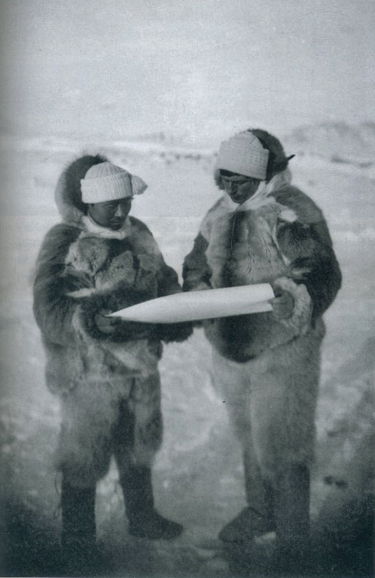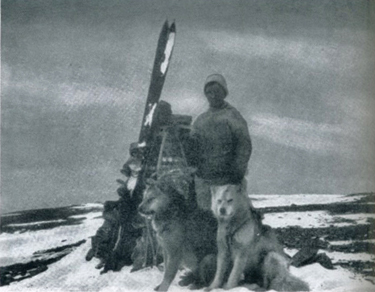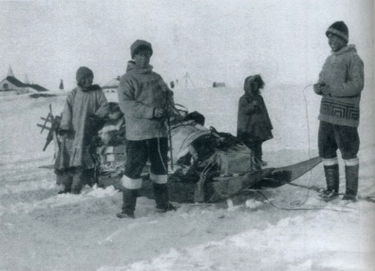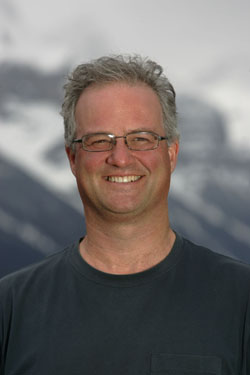From the Editor
Canadian Inuit Dogs I have owned, raised and trained: a photo essay; Part 3
Book review: Across Arctic America
Book review: White Eskimo
Interview with Author Stephen Bown
The Thule Atlas Project
March distemper outbreak in Ilulissat
Okpik’s Dream/Harry Okpik still going strong
IMHO: I’m “Neat” with Tarps
Navigating This Site
Index of articles by subject
Index of back issues by volume number
Search The Fan Hitch
Articles to download and print
Ordering Ken MacRury's Thesis
Our comprehensive list of resources
Defining the Inuit Dog
Talk to The Fan Hitch
The Fan Hitch home page
Editor: Sue Hamilton
Webmaster: Mark Hamilton
The Fan Hitch, Journal
of the Inuit Sled Dog, is published four
times a year. It is available at no cost
online at: https://thefanhitch.org.
The Fan Hitch welcomes your letters, stories, comments and suggestions. The editorial staff reserves the right to edit submissions used for publication.
Contents of The Fan Hitch are protected by international copyright laws. No photo, drawing or text may be reproduced in any form without written consent. Webmasters please note: written consent is necessary before linking this site to yours! Please forward requests to Sue Hamilton, 55 Town Line Rd., Harwinton, Connecticut 06791, USA or mail@thefanhitch.org.
This site is dedicated to the Inuit Dog as well as related Inuit culture and traditions. It is also home to The Fan Hitch, Journal of the Inuit Sled Dog.
The Fan Hitch welcomes your letters, stories, comments and suggestions. The editorial staff reserves the right to edit submissions used for publication.
Contents of The Fan Hitch are protected by international copyright laws. No photo, drawing or text may be reproduced in any form without written consent. Webmasters please note: written consent is necessary before linking this site to yours! Please forward requests to Sue Hamilton, 55 Town Line Rd., Harwinton, Connecticut 06791, USA or mail@thefanhitch.org.
This site is dedicated to the Inuit Dog as well as related Inuit culture and traditions. It is also home to The Fan Hitch, Journal of the Inuit Sled Dog.

Rasmussen (r) and Inukitsoq consult a map during the Second Thule Expedition
Photo: from The Report of the Second Thule Expedition, 1916-1918
Excerpts from an Interview with Stephen Bown, author of
White Eskimo: Knud Rasmussen’s Fearless Journey into the Heart of the Arctic
Knud Rasmussen is often credited with unlocking the culture, language, and life of the Arctic peoples. Just how influential was he compared to others who attempted similar expeditions?
There is no one else who compares to Rasmussen as a cultural explorer of the Arctic. His work is so comprehensive and detailed it covers the entire Arctic from Greenland, through the Northwest Passage, and all the way to Alaska. It is also beautifully written. His work is the foundation upon which all other studies are based. There are other great geographical explorers from the same era, such as Roald Amundsen, who sailed the Northwest Passage and was the first to reach the South Pole and the North Pole—and Rasmussen’s adventures are just as incredible for their length, danger and excitement—but Rasmussen was primarily an explorer of people not geography. Arbitrary but symbolic goals such as the North Pole were not his objective.
Rasmussen’s work showed that the soul of a people was not in its grand material culture such as its architecture or the size of its ships or cities (those are just the manifestations culture), but in its poetry, songs, legends, mythology, religious beliefs—the things that create their world view, their motivation and inspiration, their answer to the question ‘what does it mean to be alive?’. These were their expressions of humanity and understanding of the world. Rasmussen learned of this hidden culture and recorded it at the moment when these societies were on the cusp of great social and technological change, and much of it probably would have been lost without his effort to preserve it.
What characteristics made Rasmussen such an ideal candidate to complete such grueling and dangerous journeys into previously uncharted lands?
Rasmussen was born and grew up in Greenland in a family of mixed cultural and genetic heritage. His father was a Danish missionary or parson while his mother was part Inuit—so he was raised speaking Danish and the Greenland language and his playmates were mostly Inuit children. He inhabited both cultures from the day he was born. His father wasn’t a fire and brimstone pastor, but rather a humanist, an advocate rather than a dominator and crusher of local customs.
The key to Rasmussen’s success was that he was accepted as one of the people in Greenland rather than rejected as an outsider. When he arrived in a village he knew all the customary greetings and signs, the formalities. He was always one of the best dog sled drivers and best hunters in any group, and he gained instant respect for his skills. In any traditional culture, one of the advantages given to children is that the games they play and the toys they use develop the skills they will rely on as adults—the toys get bigger and the games more serious. So Rasmussen had a unique set of skills: Greenlandic on one hand and European on the other—he was educated in Copenhagen and had a great facility in written and spoken languages and a familiarity with ‘civilization’ that enabled him to bridge the gap between traditional Inuit/Eskimo culture and mainstream Western European and American culture.
But it was also his personality, his vitality and charisma, intuitive social power, that were his ågreat assets. Although barely five feet five inches tall, he dominated a room with his charm and presence. His enthusiasm was infectious and his social intelligence and intuition guided him, whether in a lecture hall in Copenhagen or New York, or a frozen beach in the Arctic.
There was nothing remotely lofty or condescending in Rasmussen’s leadership style. He insisted that Eskimos and Danes, as well as men and women, be treated as equals on his expeditions. He also insisted that his greatness as an explorer be understood only as reflected in the achievements of the members of his teams. He always praised others while saying little about his own travails and successes—other people told stories of Rasmussen’s personal exploits. When he completed his famous 20,000 mile dog sled expedition he wrote “I am overwhelmed by a warm feeling of gratitude to all our patient and uncomplaining dogs.”
Could you describe a typical day for Rasmussen when on an Arctic expedition?
Travel in the uncharted Arctic was exceedingly dangerous. People died or were injured frequently—crushed by tumbling icebergs, impaled on jagged rocks while climbing down cliffs, drowned by cracking through unstable ice, frozen in terrifyingly violent storms, gored by an enraged walrus. Lots of things could happen. Starvation was not infrequent either.
Inuit stories from Greenland to Alaska were filled with accounts of untimely death, disaster, accidents and maiming, among even the most seasoned and capable of people. Peter Freuchen nearly froze to death and had his foot amputated, another one of Rasmussen’s companions was attacked and eaten by a massive wolf. Rasmussen himself was caught in several life threatening situations, but for him the tragic ending never materialized—he was pulled into the freezing ocean by a walrus but was pulled out before he drowned; he ran short of food and was starving but he found food before he became too weak to hunt; he was caught in many blizzards and spent days exposed and freezing, but he never got serious frostbite. Nearly everything dangerous happened to Rasmussen, but he managed to escape somehow.
And the greater the hardships and danger, the more he came alive, reveling in the danger and misery. Rasmussen claimed to be happiest when enduring the hardships of polar travel. He preferred it to sitting around with nothing to do—he was always searching for interesting people to talk to and more stories and legends.

Ajako at Beaumont’s Cairn in northwest Greenland, circa 1917
Photo: from The Report of the Second Thule Expedition, 1916-1918
What did Rasmussen have to do to make to keep his dogsled team—his main mode of transportation—functioning?
Arctic sled dogs eat a lot of meat—during a rest day in winter a single dog can consume 4,500 calories—when actively hauling a loaded sled this can increase to an incredible 10,000 calories per day. Each sled was loaded in part with was vast quantities of frozen seal and fish for the dogs. Keeping the dogs fed was a prime objective because the dogs could become dangerously feral otherwise and sometimes attacked and ate each other. Life in the Arctic depended on dogs for speedy travel; if the dogs died the people might soon follow.
No matter how exhausted he was after a long day on the trail, Rasmussen always attended to his dogs first, feeding them and getting them settled. Oddly, he never used a whip to motivate them, which he attributed to years spent playing at dog sled games when he was little, with his “dogs” being his friends. He claimed that because he first dogs were his friends he never used a whip on them, and so he never developed the habit. Once he wrote that “Dogs should not pull out of fear, but out of desire.”
Rasmussen was a master with his dogs. He had his first dog team when he was 8 and he knew exactly how to organize and command dogs to get the best out of them. Many travelers commented on how he would “hypnotize” his dogs by staring into their eyes and they always obeyed him instantly. His long time travel partner Peter Freuchen wrote that Rasmussen “could always get his dogs to persevere, to do what they had to do no matter how exhausted they were. When, finally, a dog in Knud’s team laid himself down, it was death that had defeated him.” Another explorer, Therkel Mathiassen, wrote that Rasmussen “had a marvelously keen eye for the ability, faults and needs of each one of his dogs…he loved his dogs and so they loved him, not with the slavish lickspittle affection of civilized dogs, but with the half-wild beast’s feeling of ‘belonging.’”
Did Rasmussen make any significant bonds or relationships with particular natives he met on his journeys?
Well certainly. That was the key to his success—his ‘subjects’ were also his friends, not just collections of information. For nearly twenty years, Rasmussen actually spent more time in the Arctic, especially in Greenland, than he did in Europe. His cultural and social ties there were strong. Rasmussen was a famous hunter and traveler who knew everyone in northern Greenland personally and was known by reputation everywhere else. He went on many expeditions with dozens of people. One frequent travel companion, Uvdloriaq, was Freuchen’s father-inlaw and was known for his “ingenuity and perseverance” and his ability to “completely ignore sleep and hunger and all kinds of exhaustion.” Another companion, Inukitsoq, several years younger than Rasmussen, was “a tenacious and good hunter and dog driver…with a warm and good humour that never allowed him to falter in any situation” was another. The famous Greenlandic traveler Ajako, who was “almost like a son to Knud” was yet another.
Arnarulunguaq, who became the most travelled woman of her people, was his mistress during years of one journey that took them from Greenland over to Hudson Bay and then north to Canada’s arctic coast and west through Alaska, returning via Seattle, Washington, New York and Copenhagen. He knew other women for years and he even admitted to having a child with one unidentified woman. These relationships, while common in the Arctic with its more fluid family arrangements, caused a certain tension with his Danish wife whom he rarely saw for years at a time.
Rasmussen was famous throughout the northern lands, almost like a figure from mythology, credited with supernatural powers of survival. He gave rise to legends, and stories about him were told for years by those who remembered him as a child and as an adult. When he arrived it was a cause for celebration and people would travel from surrounding regions to meet him and find out what he was up to. Of course, he didn’t take this fame for granted, but he used his influence to build schools and hospitals and to organize a governing council. His whole life was devoted to the betterment of the Arctic peoples—sort of like a cultural ambassador to the outside world.

Arnarulunguaq, Rasmussen (second from left) and Miteq alongside their massive sled at Point Barrow,
Alaska near the end of their great journey. Photo: from Den Store Slaederejse
About leadership, Rasmussen was an excellent leader and his techniques and accomplishments are applicable beyond the context of a dog sled expedition. How to motivate people, manage them, deal with disaster, plan and keep good morale, as discussed above, and how to survive by emulating the Inuit, who were the true masters of exploration in the north.
But most importantly, I think, Rasmussen showed the world or revealed to the world, the fascinating inner world of the Inuit/Eskimo culture. Not the physical trappings of their culture such as their tools or clothing, but the underlying belief systems that motivated them and inspired them—the things that made up their world view and that were so different from anything in Europe or southern North America. Where others stopped looking when they beheld the squalor of Arctic encampments—a barren landscape of rock and ice, piles of chewed up bones between the huts, semi-wild dogs, greasy furs for their clothing—Rasmussen instead saw them as heroes in a mythic story, much as ancient bronze-age Greek tales of Odysseus and his adventures dwell on the heroic struggle and the enduring humanity of their quest, instead of grimy sailors with tattered garments on a creaking old ship, scabrous from the salt water, sunburned and emaciated from lack of food. It was Rasmussen’s great contribution to the world to show that it is beneath the veneer of activities or appearance where you will discover the hidden life shared by the inhabitants. A life you will not gain admittance to if you are an outsider.
Also, that artistic expression is not a luxury of complex and powerful civilizations. The rich inner world of metaphor, allegory, story and imagination, are not products of technology, powerful central government, social hierarchy, agriculture or other defining aspects of “civilization” but are inherent traits of humanity. Because of the thoroughness of his transcription of Inuit/Eskimo oral culture, and the richness of his writing and interpretation, Rasmussen brought this world view into public discourse, showing, essentially, a new way of answering the question, what does it mean to be alive, what does it mean to be human in the world?

Stephen R .Bown Photo: Craig Douce
Ed: The Fan Hitch wishes to thank author Stephen Bown and Lissa Warren of Da Capo Press for their correspondence and assistance!